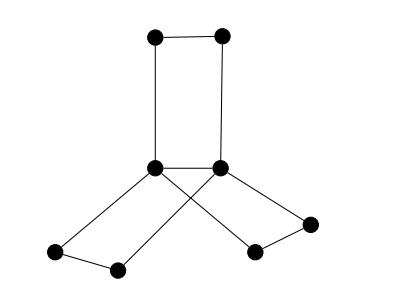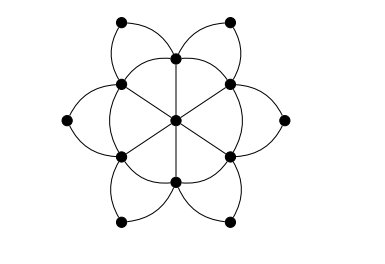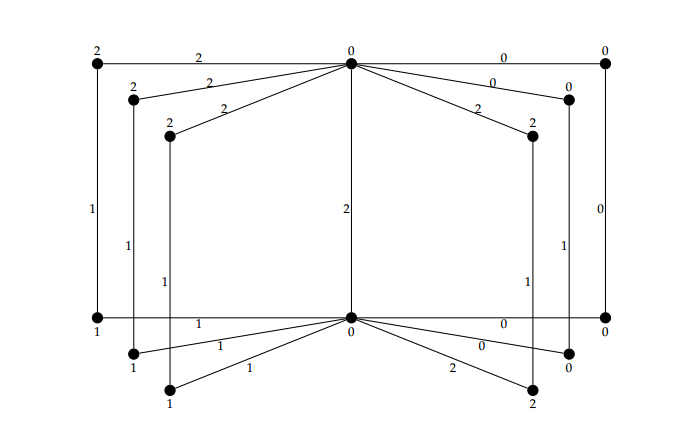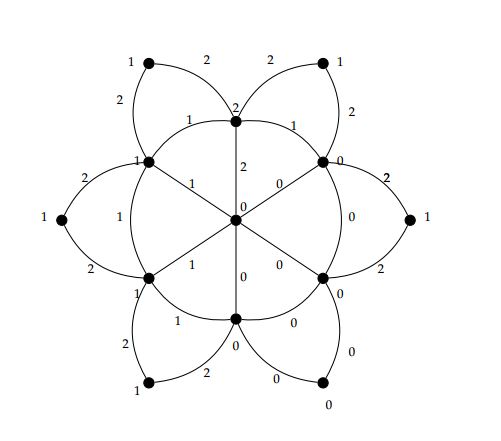In this paper, we will determine the 3-total edge product cordial (3-TEPC) labeling. We study certain classes of graphs namely tadpole, book and flower graphs in the context of 3-TEPC labeling.
We define with simple, finite and undirected graph \(G=(E_G,V_G)\), where \(E_G\) and \(V_G\) is vertex set and edge set respectively. Cordinalities of there sets are called the size and order of \(G\). We follow the standard notations and terminology of graph theory as in[1] . A graph labeling is an assignment to vertices or edges or both subject to certain conditions. If the domain is \(V_G\cup E_G\) then we called the labeling is total labeling.
We have the following notations, in order to know cordial labeling \(h\) and its sorts.Cahit [2] gave first concept of cordial labeling as a weaker version of graceful labeling. A vertex labeling \(h: V_G\rightarrow\{0, 1 \}\) that induce an edge labeling \(h^*: E_G\rightarrow\{0, 1\}\) defined by \(h^*(u v)=|h(u)-h(v)|,\) for all \(u,v\epsilon E_G\) if \(|v_{h}(1)- v_{h}(0)|\leq 1\) and \(|e_{h}(1)- e_{h}(0)|\leq 1\). The concept of product cordial labeling was introduced by Sundaram et al. in \(2014\). For details see [3]. In \(2006\) and \(2012\), Sundaram et al. develop the concept of total product cordial labeling and \(k\)-total product cordial labeling. For details see [4,5]. Vaidya and Barasara gave the concept of edge product cordial labeling and total edge product cordial labeling. For details see [6,7] Let \(k\) be an integer, \( 2\leq k\leq|E_G|\) an edge labeling \(h:E_G \longrightarrow\{0,1,\ldots,k-1\}\), with induced vertex labeling \(h^*:V_G \longrightarrow\{0,1,\ldots,k-1\}\) such that \(h^*(u)=h(e_1)h(e_2) \ldots h(e_n)\)(mod \(k\)), where edges \(e_1,e_2,\ldots,e_n \) are the edge incident to \(u\), then \(h\) is called \(k\)-total edge product cordial labeling if \(|sum(i)-sum(j)|\leq1\) for \(i,j\in\{0,1,\ldots,k-1\}\).
In 2015, Azaizeh et al. [8] was introduced the basic concept of k-total edge product cordial (\(k\)-TEPC) labeling. Recently Azaizeh et al. investigated the \(3\)-TEPC labeling for more families of graphs namely, path, circle, fan, double fan, triangular snake graph (see example [9,10]). Ahmad et al. [11] discussed \(3\)-TEPC labeling of gear, web and helm graph. Ali et al. [12] investigated the \(3\)-TEPC labeling for families of convex polytopes namely, double antiprism \(A_m\), \(S_m\) and \(T_m\). In 2018, Ahmad et al. [13] had discussed the \(3\)-TEPC labeling for hexagonal grid. Recently, Ali et al. [14] investigated the \(4\)-total edge product cordial labeling of some standard graphs. For more details see references [15,16,17,18].
Now we will define tadpole graph \((T_{p,q})\), book graph \((B_{q})\) and flower graph \((Fl_q)\) graph.
Definition 1.
The tadpole graph is obtained by connecting a cycle graph \(C_p\) (of order \(p\)) to a path graph \(P_q\) (of order q) with a bridge and is denoted by \(T_{p,q}\) (see Figure 1).

Definition 2. Book graph \(B_{q}\) is obtained by the cartesian product \(S_{q+1}\times P_2\), where \(S_{q+1}\) is the star graph of order \(q+1\) and \(P_2\) is the path graph of order \(2\) (see Figure 2).

Definition 3. The flower graph \(Fl_q\) is the graph attain from a helm graph \(H_q\) of order \(q\) by joining each pendent vertex to the apex of the helm (see Figure 3).

Theorem 1. The tadpole graph \(T_{p,q}\) has \(3\)-TEPC labeling.
Proof. Let \(V_G= \{u_j, 1\leq j \leq p\}\cup \{v_j, 1\leq j \leq q\}\) and \( E_G= \{u_j u_{j+1}, 1\leq j\leq p-1 \}\cup \{v_j v_{j+1}, 1\leq j\leq q-1\}\cup \{u_p u_1 \}\cup \{v_q u_p\} \) as shown in Figure (1). Now we see the following three cases:
Case 1 Let \(p+q\equiv 0(\text{ mod }3)\) which implies \(p+q=3t,\) for \(t\geq 3.\) So for the given case, we need to discuss the following three subcases:
Case 1.1 If \(p=0 (\text { mod } 3)\) and \(q=0 (\text { mod } 3).\) We define \(h:E_G\rightarrow\{0,1,2\}\) as:
\(h(u_j u_{j+1})=\begin{cases} 0, & \text{if \(1\leq j \leq \frac{p}{3}-1 \)};\\ 2, & \text{if \(\frac{p}{3} \leq j \leq p-1 \)}; \end{cases}\) and \(h(u_p u_1)=1.\)
\(h(v_j v_{j+1})=\begin{cases} 0, & \text{if \( 1\leq j \leq \frac{q}{3} \)};\\ 2, & \text{if \( \frac{q}{3}+1\leq j \leq q-1 \)}. \end{cases}\) , \(h(v_q u_p)=2\).
Case 1.2 If \(p > q\) but \(p\neq0 (\text { mod } 3)\) and \(q\neq0 (\text { mod } 3).\) We define \(h:E_G\rightarrow\{0,1,2\}\) as:
\(h(u_j u_{j+1})=\begin{cases} 0, & \text{if \( 1\leq j \leq t-2 \)};\\ 2, & \text{if \( t-1\leq j \leq p-1 \)}; \end{cases}\) and \(h(u_p u_1)=1\).
\(h(v_j v_{j+1})=\begin{cases} 0, & \text{if \( j = 1 \)};\\ 2, & \text{if \( 2\leq j \leq q-1 \)}. \end{cases}\) , \(h(v_q u_p)=2.\)
Case 1.3 If \(p < q\) but \(p\neq0 (\text { mod } 3)\) and \(q\neq0 (\text { mod } 3).\) We define \(h:E_G\rightarrow\{0,1,2\}\) as:
\(h(u_j u_{j+1})=\begin{cases} 0, & \text{if \( j = 1 \)};\\ 2, & \text{if \( 2\leq j \leq p-1 \)}; \end{cases}\) and \(h(u_p u_1)=1\).
\(h(v_j v_{j+1})=\begin{cases} 0, & \text{if \( 1\leq j \leq t-2 \)};\\ 2, & \text{if \( t-1\leq j \leq q-1 \)}. \end{cases}\) , \(h(v_q u_p)=2\).
So we obtain \(sum(0)=sum(1)=sum(2)=2t.\) Thus \(|sum(x_1) – sum(x_2)| \leq 1 \) for \(0 \leq x_1 < x_2 \leq 2.\) Hence \(h\) is \(3\)-TEPC labeling as discussed in Figure 4.

Case 2 Let \(p+q\equiv 1(\text{ mod }3)\) which implies \(p+q=3t+1,\) for \(t\geq 3.\) So for the given case, we need to discuss the following three subcases:
Case 2.1 If \(p=0 (\text { mod } 3)\) and \(q\neq0 (\text { mod } 3).\) We define \( h:E_G\rightarrow\{0,1,2\}\) as:
\(h(u_j u_{j+1})=\begin{cases} 0, & \text{if \( 1\leq j \leq \frac{p}{3}-1 \)};\\ 2, & \text{if \( \frac{p}{3} \leq j \leq p-1 \)}; \end{cases}\) and \(h(u_p u_1)=1.\)
\(h(v_j v_{j+1})=\begin{cases} 0, & \text{if \( 1\leq j \leq \frac{q-1}{3} \)};\\ 2, & \text{if \( \frac{q-1}{3}+1\leq j \leq q-1 \)}. \end{cases}\) , \(h(v_q u_p)=2.\)
Case 2.2 If \(p\neq0 (\text { mod } 3)\) and \(q=0 (\text { mod } 3).\) We define \( h:E_G\rightarrow\{0,1,2\}\) as:
\(g(u_j u_{j+1})=\begin{cases} 0, & \text{if \( 1\leq j \leq \frac{p-1}{3}-1 \)};\\ 2, & \text{if \(\frac{p-1}{3} \leq j \leq p-1 \)}; \end{cases}\) and \(h(u_p u_1)=1.\)
\(h(v_j v_{j+1})=\begin{cases} 0, & \text{if \( 1\leq j \leq \frac{q}{3} \)};\\ 2, & \text{if \( \frac{q}{3}+1\leq j \leq q-1 \)}. \end{cases}\) , \(h(v_q u_p)=2.\)
Case 2.3 If \(p\neq0 (\text { mod } 3)\) and \(q\neq0 (\text { mod } 3).\) We define \( h:E_G\rightarrow\{0,1,2\}\) as:
\(h(u_j u_{j+1})=\begin{cases} 0, & \text{if \( 1\leq j \leq \frac{p-2}{3} \)};\\ 2, & \text{if \(\frac{p-2}{3}+1 \leq j \leq p-1 \)}; \end{cases}\) and \(h(u_p u_1)=1.\)
\(h(v_j v_{j+1})=\begin{cases} 0, & \text{if \( 1\leq j \leq \frac{q-2}{3} \)};\\ 2, & \text{if \( \frac{q-2}{3}+1\leq j \leq q-1 \)}. \end{cases}\) , \(h(v_q u_p)=2.\)
So we obtain \(sum(0)=2t\), \(sum(1)=sum(2)=2t+1.\) Thus \(|sum(x_1) – sum(x_2)| \leq 1 \) for \(0 \leq x_1 < x_2 \leq 2.\) Hence \(h\) is \(3\)-TEPC labeling as discussed in Figure 5.

Case 3 Let \(p+q\equiv 2(\text{ mod }3)\) which implies \(p+q=3t+2,\) for \(t\geq 3\). So for the given case, we need to discuss the following three subcases:
Case 3.1 If \(p=0 (\text { mod } 3)\) and \(q\neq0 (\text { mod } 3).\) We define \( h:E_G\rightarrow\{0,1,2\}\) as:
\(h(u_j u_{j+1})=\begin{cases} 0, & \text{if \( 1\leq j \leq \frac{p}{3} \)};\\ 2, & \text{if \( \frac{p}{3}+1 \leq j \leq p-1 \)}; \end{cases}\) and \(h(u_p u_1)=1.\)
\(h(v_j v_{j+1})=\begin{cases} 0, & \text{if \( 1\leq j \leq \frac{q-2}{3} \)};\\ 2, & \text{if \( \frac{q-2}{3}+1\leq j \leq q-1 \)}. \end{cases}\) , \(h(v_q u_p)=2. \)
Case 3.2 If \(p\neq0 (\text { mod } 3)\) and \(q=0 (\text { mod } 3).\) We define \( h:E_G\rightarrow\{0,1,2\}\) as:
\(h(u_j u_{j+1})=\begin{cases} 0, & \text{if \( 1\leq j \leq \frac{p-2}{3} \)};\\ 2, & \text{if \( \frac{p-2}{3}+1 \leq j \leq p-1 \)}; \end{cases}\) and \(h(u_p u_1)=1.\)
\(h(v_j v_{j+1})=\begin{cases} 0, & \text{if \( 1\leq j \leq \frac{q}{3} \)};\\ 2, & \text{if \(\frac{q}{3}+1\leq j \leq q-1 \)}. \end{cases}\) , \(h( v_q u_p)=2. \)
Case 3.3 If \(p\neq0 (\text { mod } 3)\) and \(q\neq0 (\text { mod } 3).\) We define \( h:E_G\rightarrow\{0,1,2\}\) as:
\(h(u_j u_{j+1})=\begin{cases} 0, & \text{if \( 1\leq j \leq \frac{p-1}{3} \)};\\ 2, & \text{if \( \frac{p-1}{3}+1 \leq j \leq p-1 \)}; \end{cases}\) and \(h(u_p u_1)=1.\)
\(h(v_j v_{j+1})=\begin{cases} 0, & \text{if \( 1\leq j \leq \frac{q-1}{3} \)};\\ 2, & \text{if \( \frac{q-1}{3}+1\leq j \leq q-1 \)}. \end{cases}\) , \(h(v_q u_p)=2. \)
So we obtain \(sum(0)=2t+2\), \(sum(1)=sum(2)=2t+1.\) Thus \(|sum(x_1) – sum(x_2)| \leq 1 \) for \(0 \leq x_1 < x_2 \leq 2.\) Hence \(h\) is \(3\)-TEPC labeling as discussed in Figure 6.

Theorem 2. The book graph \(B_q\) has \(3\)-TEPC labeling.
Proof. Let \(V_G= \{u,v,u_j,v_j, 1\leq j \leq q\}\) and \( E_G= \{u u_j, 1\leq j\leq q \} \cup \{v v_j, 1\leq j\leq q\}\cup \{u_j v_j, 1\leq j\leq q \}\cup \{u v\}\) as shown in Figure 2. Now we see the following three cases:
Case 1 Let \(q\equiv0 \text{ (mod }3)\) which implies \(q= 3t\), for \(t\geq1\). We define \( h:E_G\rightarrow\{0,1,2\}\) as:
Case 1.1 Now we define edge labeling if \(t\) is even:
\(h(u u_j)=\begin{cases} 0, & \text{if \( 1\leq j \leq t; \)}\\ 2, & \text{if \( t+1\leq j \leq 3t. \)} \end{cases} \)
,\(h(u_j v_j)=\begin{cases} 0, & \text{if \( 1\leq j \leq t-1; \)}\\ 1, & \text{if \( t\leq j \leq 3t. \)} \end{cases} \)
\(h(v v_j)=\begin{cases} 0, & \text{if \( 1\leq j \leq t; \)}\\ 2, & \text{if \( t+1\leq j \leq \frac{3t}{2}; \)}\\ 1, & \text{if \( \frac{3t}{2}+1\leq j \leq 3t. \)} \end{cases} \) , \(h(uv)=2\)
.1.2 Now we define edge labeling if \(t\) is odd:
\(h(u u_j)=\begin{cases} 0, & \text{if \( 1\leq j \leq t; \)}\\ 2, & \text{if \( t+1\leq j \leq 3t. \)} \end{cases} \)
,\(h(u_j v_j)=\begin{cases} 0, & \text{if \( 1\leq j \leq t-1; \)}\\ 1, & \text{if \( t\leq j \leq 3t. \)} \end{cases} \)
\(h(v v_j)=\begin{cases} 0, & \text{if \( 1\leq j \leq t; \)}\\ 2, & \text{if \( t+1\leq j \leq \frac{3t+1}{2}; \)}\\ 1, & \text{if \( \frac{3t+1}{2}+1\leq j \leq 3t. \)} \end{cases} \) , \(h(uv)=1\)
So we obtain \(sum(0)=sum(1)=sum(2)=5t+1.\) Thus \(|sum(x_1) – sum(x_2)| \leq 1 \) for \(0 \leq x_1 < x_2 \leq 2.\) Hence \(h\) is \(3\)-TEPC labeling.
Case 2 Let \(q\equiv1 \text{ (mod }3)\) which implies \(q= 3t+1\), for \(t\geq1\). We define \( h:E_G\rightarrow\{0,1,2\}\) as:
Case 2.1 Now we define edge labeling if \(t\) is even:
\(h(v v_j)=\begin{cases} 0, & \text{if \( 1\leq j \leq t; \)}\\ 2, & \text{if \( t+1\leq j \leq 3t+1. \)} \end{cases} \)
,\(h(u_j v_j)=\begin{cases} 0, & \text{if \( 1\leq j \leq t; \)}\\ 1, & \text{if \( t+1\leq j \leq 3t+1. \)} \end{cases} \)
\(h(u u_j)=\begin{cases} 0, & \text{if \( 1\leq j \leq t; \)}\\ 2, & \text{if \( t+1\leq j \leq \frac{3t}{2}; \)}\\ 1, & \text{if \( \frac{3t}{2}+1\leq j \leq 3t+1. \)} \end{cases} \) , \(h(uv)=2\).
Case 2.2 Now we define edge labeling if \(t\) is odd:
\(h(v v_j)=\begin{cases} 0, & \text{if \( 1\leq j \leq t; \)}\\ 2, & \text{if \( t+1\leq j \leq 3t+1. \)} \end{cases} \)
,\(h(u_j v_j)=\begin{cases} 0, & \text{if \( 1\leq j \leq t; \)}\\ 1, & \text{if \( t+1\leq j \leq 3t+1. \)} \end{cases} \)
\(h(uu_j)=\begin{cases} 0, & \text{if \( 1\leq j \leq t; \)}\\ 2, & \text{if \( t+1\leq j \leq \frac{3t+1}{2}; \)}\\ 1, & \text{if \( \frac{3t+1}{2}+1\leq j \leq 3t+1. \)} \end{cases} \) , \(h(uv)=1\).
So we obtain \(sum(0)=5t+2\), \(sum(1)=sum(2)=5t+3.\) Thus \(|sum(x_1) – sum(x_2)| \leq 1 \) for \(0 \leq x_1 < x_2 \leq 2.\) Hence \(h\) is \(3\)-TEPC labeling.
Case 3Let \(q\equiv2 \text{ (mod }3)\) which implies \(q= 3t+2\), for \(t\geq1\). We define \( h:E_G\rightarrow\{0,1,2\}\) as:
Case 3.1 Now we define edge labeling if \(t\) is even:
\(h(v v_j)=\begin{cases} 0, & \text{if \( 1\leq j \leq t; \)}\\ 2, & \text{if \( t+1\leq j \leq 3t+2. \)} \end{cases} \)
,\(h(u_j v_j)=\begin{cases} 0, & \text{if \( 1\leq j \leq t; \)}\\ 1, & \text{if \( t+1\leq j \leq 3t+2. \)} \end{cases} \)
\(h(uu_j)=\begin{cases} 0, & \text{if \( 1\leq j \leq t+1; \)}\\ 2, & \text{if \( t+2\leq j \leq \frac{3t}{2}+1; \)}\\ 1, & \text{if \( \frac{3t}{2}+2\leq j \leq 3t+2. \)} \end{cases} \) , \(h(uv)=0\).
Case 3.2 Now we define edge labeling if \(t\) is odd:
\(h(vv_j)=\begin{cases} 0, & \text{if \( 1\leq j \leq t; \)}\\ 2, & \text{if \( t+1\leq j \leq 3t+2. \)} \end{cases} \)
,\(h(u_j v_j)=\begin{cases} 0, & \text{if \( 1\leq j \leq t+1; \)}\\ 1, & \text{if \( t+2\leq j \leq 3t+2. \)} \end{cases} \)
\(h(uu_j)=\begin{cases} 0, & \text{if \( 1\leq j \leq t; \)}\\ 2, & \text{if \( t+1\leq j \leq \frac{3t+1}{2}; \)}\\ 1, & \text{if \( \frac{3t+1}{2}+1\leq j \leq 3t+2. \)} \end{cases} \) , \(h(uv)=2\).
So we obtain \(sum(0)=5t+5\), \(sum(1)=sum(2)=5t+4.\) Thus \(|sum(x_1) – sum(x_2)| \leq 1 \) for \(0 \leq x_1 < x_2 \leq 2.\) Hence \(h\) is \(3\)-TEPC labeling.
Example 1.The graph \(B_6\) and its given \(3\)-TEPC labeling as shown in Figure 7.

Theorem 3. The flower graph \(Fl_q\) has \(3\)-TEPC labeling.
Proof. Let \(V_G= \{u,u_j,v_j, 1\leq j \leq q\}\) and \( E_G= \{u u_j, 1\leq j\leq q \} \cup \{u_j u_{j+1}, 1\leq j\leq q-1\}\cup \{u_j v_j, 1\leq j\leq q \}\cup \{u_{j+1} v_j, 1\leq j\leq q-1 \}\cup \{u_q u_1\}\cup \{u_1 v_q\}\) as shown in Figure 3. Now we see the following three cases:
Case 1 Let \(q\equiv0 \text{ (mod }3)\) which implies \(q= 3t\), for \(t \geq1\). We define \( h:E_G\rightarrow\{0,1,2\}\) as:
\(h(u_j u_{j+1})=\begin{cases} 0, & \text{if \( 1\leq j \leq t; \)}\\ 1, & \text{if \( t+1\leq j \leq 3t-1; \)} \end{cases} \) and \(h(u_{3t } u_1)=1.\)
\(h(u_{j+1} v_j)=\begin{cases} 0, & \text{if \( 1 \leq j \leq t-1; \)}\\ 2, & \text{if \( t \leq j \leq 3t-1; \)} \end{cases} \) and \(h(u_1 v_{3t})=2.\)
\(h(u u_j)=\begin{cases} 0, & \text{if \( 1\leq j \leq t +1; \)}\\ 2, & \text{if \( t+2 \leq j \leq 2t; \)}\\ 1, & \text{if \( 2t+1\leq j \leq 3t . \)} \end{cases} \)
,\(h(u_j v_j)=\begin{cases} 0, & \text{if \( 1 \leq j \leq t-1; \)}\\ 2, & \text{if \( t \leq j \leq 3t. \)} \end{cases} \)
So we obtain \(sum(1)=6t+1\), \(sum(0)=sum(2)=5t.\) Thus \(|sum(x_1) – sum(x_2)| \leq 1 \) for \(0 \leq x_1 < x_2 \leq 2.\) Hence \(h\) is \(3\)-TEPC labeling.
Case 2 Let \(q\equiv1 \text{ (mod }3)\) which implies \(q= 3t+1\), for \(t\geq1\). We define \( h:E_G\rightarrow\{0,1,2\}\) as:
\(h(u_j u_{j+1})=\begin{cases} 0, & \text{if \( 1\leq j \leq t; \)}\\ 1, & \text{if \( t+1\leq j \leq 3t; \)} \end{cases} \) and \(h(u_j u_{3t+1})=1.\)
\(h(u_{j+1} v_j)=\begin{cases} 0, & \text{if \( 1 \leq j \leq t; \)}\\ 2, & \text{if \( t+1 \leq j \leq 3t; \)} \end{cases} \) and \(h(u_1 v_{3t+1})=2.\)
\(h(u u_j)=\begin{cases} 0, & \text{if \( 1\leq j \leq t+1; \)}\\ 2, & \text{if \( t+2 \leq j \leq 2t+1; \)}\\ 1, & \text{if \( 2t+2\leq j \leq 3t+1. \)} \end{cases} \)
,\(h(u_j v_j)=\begin{cases} 0, & \text{if \( 1 \leq j \leq t; \)}\\ 2, & \text{if \( t+1 \leq j \leq 3t+1. \)} \end{cases} \)
So we obtain \(sum(0)=6t+3\), \(sum(1)=sum(2)=5t+2.\) Thus \(|sum(x_1) – sum(x_2)| \leq 1 \) for \(0 \leq x_1 < x_2 \leq 2.\) Hence \(h\) is \(3\)-TEPC labeling.
Case 3 Let \(q\equiv2 \text{ (mod }3)\) which implies \(q= 3t+2\), for \(t\geq1\). We define \( h:E_G\rightarrow\{0,1,2\}\) as:
\(h(u_j u_{j+1})=\begin{cases} 0, & \text{if \( 1\leq j \leq t; \)}\\ 2, & \text{if \( t+1\leq j \leq 3t+1; \)} \end{cases} \) and \(h(u_{3t+2} u_1)=2.\)\\
\(h(u_{j+1} v_j)=\begin{cases} 0, & \text{if \( 1 \leq j \leq t; \)}\\ 1, & \text{if \( t+1 \leq j \leq 3t+1; \)} \end{cases} \) and \(h(u_1 v_{3t+2})=1.\)
\(h(u u_j)=\begin{cases} 0, & \text{if \( 1\leq j \leq t+1; \)}\\ 2, & \text{if \( t+2 \leq j \leq 3t+2. \)} \end{cases} \)
,\(h(u_j v_j)=\begin{cases} 0, & \text{if \( 1 \leq j \leq t+1; \)}\\ 1, & \text{if \( t+2 \leq j \leq 3t+2. \)} \end{cases} \)
So we obtain \(sum(0)=6t+5\), \(sum(1)=sum(2)=5t+4.\) Thus \(|sum(x_1) – sum(x_2)| \leq 1 \) for \(0 \leq x_1 < x_2 \leq 2.\) Hence \(h\) is \(3\)-TEPC labeling.
Example 2. The graph \(Fl_6\) and its given \(3\)-TEPC labeling as shown in Figure 8.

